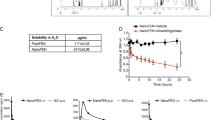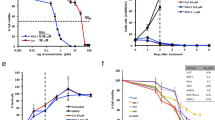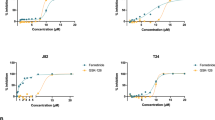Abstract
Retinoid-related molecules are important potential agents for the treatment of cancer. In the present study, we test the effect of a novel retinoid-related ligand, AGN193198 (4-[3-(1-heptyl-4,4-dimethyl-2-oxo-1,2,3,4-tetrahydroquinolin-6-yl)-3-oxo-prophenyl] benzoic acid), on pancreatic cancer cell proliferation and survival. AGN193198 treatment reduces BxPC-3 cell proliferation more efficiently than high-affinity retinoid acid receptor (RAR)- or retinoid X receptor (RXR)-selective retinoids. Moreover, AGN193198 does not activate transcription from RAR or RXR response elements and its effects on cell survival are not reversed by treatment with RAR- or RXR receptor-selective antagonists. These results suggest that the AGN193198-dependent inhibition of BxPC-3 cell function is not mediated via activation of the classical retinoid receptors. Cell cycle analysis of AGN193198-treated BxPC-3 cells indicates that AGN193198 causes accumulation of cells in G2/M. This change is associated with a marked reduction in regulators of S (cyclin A, cyclin-dependent kinase (cdk)2), G2/M (cyclin B1, cdk1, cdc25c) and G1 (cyclin D1, cyclin E, cdk2, cdk4) phase, and an increase in p21 and p27 level. Kinases assays reveal that cdk1, cdk2 and cdk4 activity are suppressed in AGN193198-treated cells. In addition, reduced cell proliferation is associated with enhanced procaspase (3, 8 and 9) and PARP cleavage. Z-VAD-FMK, a pancaspase inhibitor, inhibits AGN193198-dependent caspase activation and attenuates cell death. Z-VAD-FMK inhibits PARP cleavage, but does not alter the AGN193198-dependent reduction in cell cycle regulatory protein expression and activity, suggesting that caspase activation and suppression of cell cycle regulatory protein levels are independent processes. AGN193198 produces similar responses in other pancreatic cancer cell lines including AsPC-1 and MIA PaCa-2. These studies suggest that AGN193198 may be useful for the treatment of pancreatic cancer.
This is a preview of subscription content, access via your institution
Access options
Subscribe to this journal
Receive 50 print issues and online access
$259.00 per year
only $5.18 per issue
Buy this article
- Purchase on Springer Link
- Instant access to full article PDF
Prices may be subject to local taxes which are calculated during checkout











Similar content being viewed by others
Abbreviations
- RAR:
-
retinoid acid receptors
- RXR:
-
retinoid X receptors
- cdk:
-
cyclin-dependent kinase
- RRM:
-
retinoid-related molecule
- PARP:
-
poly(ADP-ribose) polymerase
References
Albrechtsson E, Ohlsson B and Axelson J . (2002). Pancreas, 25, 49–56.
Altucci L and Gronemeyer H . (2001). Nat. Rev. Cancer, 1, 181–193.
Arbuck SG . (1990). Baillieres Clin. Gastroenterol., 4, 953–968.
Balasubramanian S, Chandraratna RA and Eckert RL . (2004). Carcinogenesis, 25, 1377–1385.
Balasubramanian S, Efimova T and Eckert RL . (2002). J. Biol. Chem., 277, 1828–1836.
Bayon Y, Ortiz MA, Lopez-Hernandez FJ, Gao F, Karin M, Pfahl M and Piedrafita FJ . (2003). Mol. Cell. Biol., 23, 1061–1074.
Benbrook DM, Subramanian S, Gale JB, Liu S, Brown CW, Boehm MF and Berlin KD . (1998). J. Med. Chem., 41, 3753–3757.
Brand N, Petkovich M, Krust A, Chambon P, de The H, Marchio A, Tiollais P and Dejean A . (1988). Nature, 332, 850–853.
Brembeck FH, Kaiser A, Detjen K, Hotz H, Foitzik T, Buhr HJ, Riecken EO and Rosewicz S . (1998a). Br. J. Cancer, 78, 1288–1295.
Brembeck FH, Schoppmeyer K, Leupold U, Gornistu C, Keim V, Mossner J, Riecken EO and Rosewicz S . (1998b). Cancer, 83, 2317–2323.
Chiesa F, Tradati N, Marazza M, Rossi N, Boracchi P, Mariani L, Clerici M, Formelli F, Barzan L, Carrassi A, Pastorini A, Camerini T, Giardini R, Zurrida S, Minn FL, Costa A, De Palo G and Veronesi V . (1992). Eur. J. Cancer B Oral Oncol., 28B, 97–102.
Chun KH, Benbrook DM, Berlin KD, Hong WK and Lotan R . (2003). Cancer Res., 63, 3826–3832.
Crettaz M, Baron A, Siegenthaler G and Hunziker W . (1990). Biochem. J., 272, 391–397.
Dawson MI, Hobbs PD, Peterson VJ, Leid M, Lange CW, Feng KC, Chen G, Gu J, Li H, Kolluri SK, Zhang X, Zhang Y and Fontana JA . (2001). Cancer Res., 61, 4723–4730.
Egawa N, Maillet B, VanDamme B, De Greve J and Kloppel G . (1996). Virchows Arch., 429, 59–68.
Fontana JA and Rishi AK . (2002). Leukemia, 16, 463–472.
Fujimoto K, Hosotani R, Doi R, Wada M, Lee JU, Koshiba T, Miyamoto Y, Tsuji S, Nakajima S and Imamura M . (1999). Int. J. Cancer, 81, 637–644.
Garattini E, Gianni M and Terao M . (2004a). Curr. Pharm. Des., 10, 433–448.
Garattini E, Parrella E, Diomede L, Gianni M, Kalac Y, Merlini L, Simoni D, Zanier R, Ferrara FF, Chiarucci I, Carminati P, Terao M and Pisano C . (2004b). Blood, 103, 194–207.
Hammond LA, Brown G, Keedwell RG, Durham J and Chandraratna RA . (2002). Anticancer Drugs, 13, 781–790.
Heyman RA, Mangelsdorf DJ, Dyck JA, Stein RB, Eichele G, Evans RM and Thaller C . (1992). J. Cell Biochem., 68, 397–406.
Holmes WF, Soprano DR and Soprano KJ . (2003). J. Cell Biochem., 89, 262–278.
Hruban RH, Goggins M, Parsons J and Kern SE . (2000). Clin. Cancer Res., 6, 2969–2972.
Hsieh TC and Wu JM . (1997). Prostate, 33, 97–104.
Hsu CA, Rishi AK, Su-Li X, Gerald TM, Dawson MI, Schiffer C, Reichert U, Shroot B, Poirer GC and Fontana JA . (1997). Blood, 89, 4470–4479.
Ji BT, Chow WH, Gridley G, Mclaughlin JK, Dai Q, Wacholder S, Hatch MC, Gao YT and Fraumeni Jr JF . (1995). Cancer Epidemiol. Biomarkers Prev., 4, 885–893.
Johnson A and Chandraratna RA . (1999). Br. J. Dermatol., 140 (Suppl 54), 12–17.
Kaiser A, Wolf-Breitinger M, Albers A, Dorbic T, Wittig B, Riecken EO and Rosewicz S . (1998). Gastroenterology, 115, 967–977.
Kawa S, Nikaido T, Aoki Y, Zhai Y, Kumagaya T, Furihata K, Fujii S and Kiyosawa K . (1997). Int. J. Cancer, 72, 906–911.
Keedwell RG, Zhao Y, Hammond LA, Qin S, Tsang KY, Reitmair A, Molina Y, Okawa Y, Atangan LI, Shurland DL, Wen K, Wallace DM, Bird R, Chandraratna RA and Brown G . (2004). Cancer Res., 64, 3302–3312.
Levine DS, Sanchez CA, Rabinovitch PS and Reid BJ . (1991). Proc. Natl. Acad. Sci. U.S.A, 88, 6427–6431.
Li D, Xie K, Wolff R and Abbruzzese JL . (2004). Lancet, 363, 1049–1057.
Liu S, Brown CW, Berlin KD, Dhar A, Guruswamy S, Brown D, Gardner GJ, Birrer MJ and Benbrook DM . (2004). J. Med. Chem., 47, 999–1007.
Lopez-Hernandez FJ, Ortiz MA, Bayon Y and Piedrafita FJ . (2004). Cell Death Differ., 11, 154–164.
Lotan R . (2003). J. Biol. Regul. Homeost. Agents, 17, 13–28.
Mangelsdorf DJ, Borgmeyer U, Heyman RA, Zhou JY, Ong ES, Oro AE, Kakizuka A and Evans RM . (1992). Genes Dev., 6, 329–344.
McGowan CH . (2003). Prog. Cell Cycle Res., 5, 1–4.
Nagpal S and Chandraratna RA . (2000). Curr. Pharm. Des., 6, 919–931.
Nicoletti VG and Stella AM . (2003). Neurochem. Res., 28, 187–194.
Oridate N, Higuchi M, Suzuki S, Shroot B, Hong WK and Lotan R . (1997). Int. J. Cancer, 70, 484–487.
Ortiz MA, Bayon Y, Lopez-Hernandez FJ and Piedrafita FJ . (2002). Drug Resist. Updat., 5, 162–175.
Paik J, Blaner WS, Sommer KM, Moe R and Swisshlem K . (2003). Cancer Invest., 21, 304–312.
Petkovich M, Brand NJ, Krust A and Chambon P . (1987). Nature, 330, 444–450.
Pettersson F, Colston KW and Dalgleish AG . (2000). Br. J. Cancer, 83, 239–245.
Pettersson F, Colston KW and Dalgleish AG . (2001). Pancreas, 23, 273–279.
Pettersson F, Dalgleish AG, Bissonnette RP and Colston KW . (2002). Br. J. Cancer, 87, 555–561.
Pienta KJ, Nguyen NM and Lehr JE . (1993). Cancer Res., 53, 224–226.
Rosenberg L . (2000). Drugs, 59, 1071–1089.
Rosenberg L and Lipsett M . (2003). Expert Opin. Biol. Ther., 3, 319–337.
Rosewicz S, Brembeck F, Kaiser A, Marschall ZV and Riecken EO . (1996). Endocrinology, 137, 3340–3347.
Rosewicz S, Stier U, Brembeck F, Kaiser A, Papadimitriou CA, Berdel WE, Wiedenmann B and Riecken EO . (1995). Gastroenterology, 109, 1646–1660.
Shao ZM, Dawson MI, Li XS, Rishi AK, Sheikh MS, Han QX, Ordonez JV, Shroot B and Fontana JA . (1995). Oncogene, 11, 493–504.
Shi Y . (2002). Mol. Cell, 9, 459–470.
Spruce LW, Gale JB, Berlin KD, Verma AK, Breitman TR, Ji XH and van der HD . (1991). J. Med. Chem., 34, 430–439.
Standeven AM, Thacher SM, Yuan YD, Escobar M, Vuligonda V, Beard RL and Chandraratna RA . (2001). Biochem. Pharmacol., 62, 1501–1509.
Strickland S, Breitman TR, Frickel F, Nurrenbach A, Hadicke E and Sporn MB . (1983). Cancer Res., 43, 5268–5272.
Sun SY, Kurie JM, Yue P, Dawson MI, Shroot B, Chandraratna RA, Hong WK and Lotan R . (1999). Clin. Cancer Res., 5, 431–437.
Sun SY and Lotan R . (2002). Crit. Rev. Oncol. Hematol., 41, 41–55.
Sun SY, Yue P, Shroot B, Hong WK and Lotan R . (1997). J. Cell. Physiol., 173, 279–284.
Supino R, Crosti M, Clerici M, Warlters A, Cleris L, Zunino F and Formelli F . (1996). Int. J. Cancer, 65, 491–497.
Teelmann K, Tsukaguchi T, Klaus M and Eliason JF . (1993). Cancer Res., 53, 2319–2325.
Vermeulen K, Van Bockstaele DR and Berneman ZN . (2003). Cell Prolif., 36, 131–149.
Vuligonda V, Thacher SM and Chandraratna RA . (2001). J. Med. Chem., 44, 2298–2303.
Zelent A, Krust A, Petkovich M, Kastner P and Chambon P . (1989). Nature, 339, 714–717.
Zuco V, Zanchi C, Cassinelli G, Lanzi C, Supino R, Pisano C, Zanier R, Giordano V, Garattini E and Zunino F . (2004). Cell Death. Differ., 11, 280–289.
Zusi FC, Lorenzi MV and Vivat-Hannah V . (2002). Drug Discov. Today, 7, 1165–1174.
Acknowledgements
This work utilized the facilities of the Skin Diseases Research Center of Northeast Ohio (NIH, AR39750) and was partially supported by Allergan Inc.
Author information
Authors and Affiliations
Corresponding author
Rights and permissions
About this article
Cite this article
Balasubramanian, S., Chandraratna, R. & Eckert, R. A novel retinoid-related molecule inhibits pancreatic cancer cell proliferation by a retinoid receptor independent mechanism via suppression of cell cycle regulatory protein function and induction of caspase-associated apoptosis. Oncogene 24, 4257–4270 (2005). https://doi.org/10.1038/sj.onc.1208586
Received:
Revised:
Accepted:
Published:
Issue Date:
DOI: https://doi.org/10.1038/sj.onc.1208586
Keywords
This article is cited by
-
13-cis Retinoic Acid Induces Apoptosis and Cell Cycle Arrest in Human SEB-1 Sebocytes
Journal of Investigative Dermatology (2006)
-
Isotretinoin Revisited: Pluripotent Effects on Human Sebaceous Gland Cells
Journal of Investigative Dermatology (2006)



